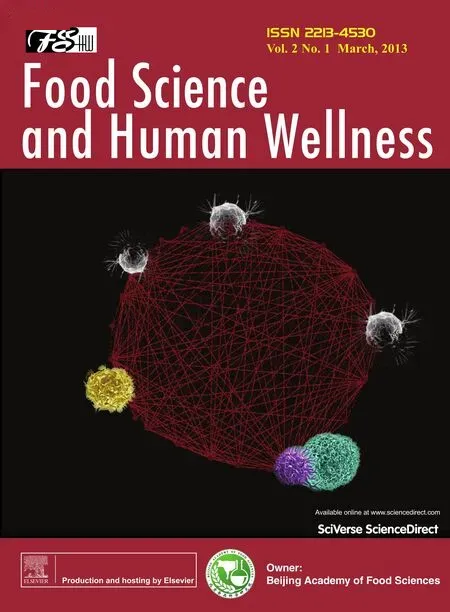Black tea in chemo-prevention of cancer and other human diseases
Min-Hsiung Pn Ching-Shu Li Hong Wng Chih-Yu Lo Chi-Tng Ho Shiming Li
a Department of Seafood Science,National Kaohsiung Marine University,Kaohsiung 811,Taiwan,China
b Shaklee Corporation,4747 Willow Road,Pleasanton,CA 94588,USA
c Department of Food Science,National Chiayi University,Chiayi City 60004,Taiwan,China
d Department of Food Science,Rutgers University,New Brunswick,NJ 08901,USA
e Hubei Key Laboratory of Economic Forest Germplasm Improvement and Resources Comprehensive Utilization,Huanggang Normal University,Huanggang 438000,China
Abstract Tea is the most popular functional beverage in the world and has been gaining more and more attention for its health beneficia properties.Among common teas,black tea is consumed more than green tea and oolong tea worldwide.Numerous studies have shown the biological activities of black tea and its polyphenols that include anti-oxidant,anti-tumor,anti-inflammatio and metabolic regulation.Tea polyphenols such as theaflvins and catechins are considered to be multifunctional compounds that could be effective in the prevention or treatment of various cancers,cardiovascular disease,chronic inflammation obesity,metabolic syndrome,and neurodegenerative diseases.In this review,we summarized the up-to-date research and underlying molecular mechanisms of black tea and its polyphenols.
Keywords:Black tea;Theaflvins;Catechins;Human disease;Molecular mechanism;Cancer
1.Introduction
As tea drinking has become part of a phenomenal global culture nowadays,it is mainly attributed to its biological functionality in contrast to the traditional tea drinking,which is mostly driven by its flvor and stimulant effect.Indeed,polyphenolic compounds in tea have many health promoting activities due to their diverse biological actions including antioxidant,anti-inflammator,anti-tumor and metabolic regulatory effects that could lead to cancer prevention and protect against metabolic,cardiovascular and inflammator diseases.
Since black tea consumption accounts for 78%of the overall tea beverage industry [1],we directed our attention to the studies of black tea in both its chemistry and biological activities.In our previous review,we focused on the chemistry of black tea:the formation,composition,analysis and stability of black tea[1].From the reported data and our analysis,we concluded that the major polyphenols in black tea are composed of theaflvins (Table 1) and catechins (Table 2).Black tea is different from other tea such as green tea,white tea and oolong tea not only in their processing and flvor,but also in their chemical compositions.Chemical analysis showed that black tea also contains high amount of green tea catechins in addition to theaflvins.Therefore,both catechins and theaflvins contribute to the bioactivity of black tea either by additive and/or synergistic effects.
Numerous articles have summarized the biological properties of green tea and its catechins and a few have reviewed bioactivity of black tea in general.However,few articles have attributed the bioactivity data of black tea to its chemical profiles In this review,we summarized the health beneficia properties of black tea and also listed the bioactivities ofindividual theaflvins(TFs),the key identity marker of black tea.By describing various health promoting effects of black tea and the potential mechanisms from its major ingredients,we would like to advocate the importance of chemical profilin in natural product research and functional food products development.
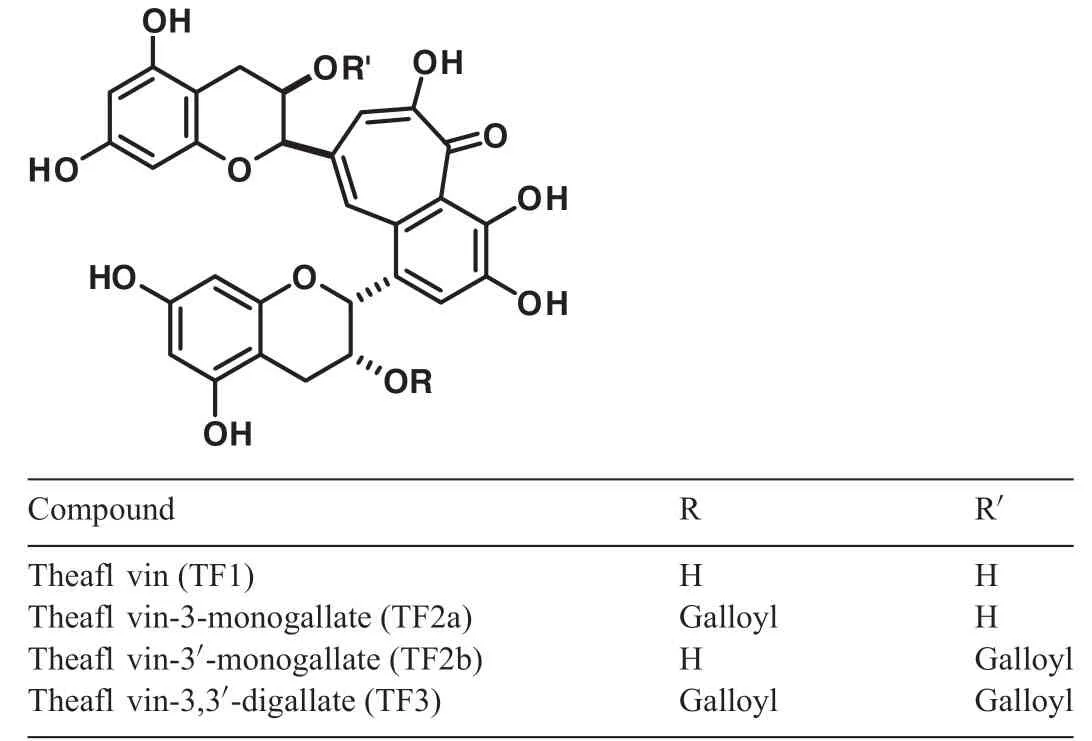
Table 1 Chemical structure of theaflvins.
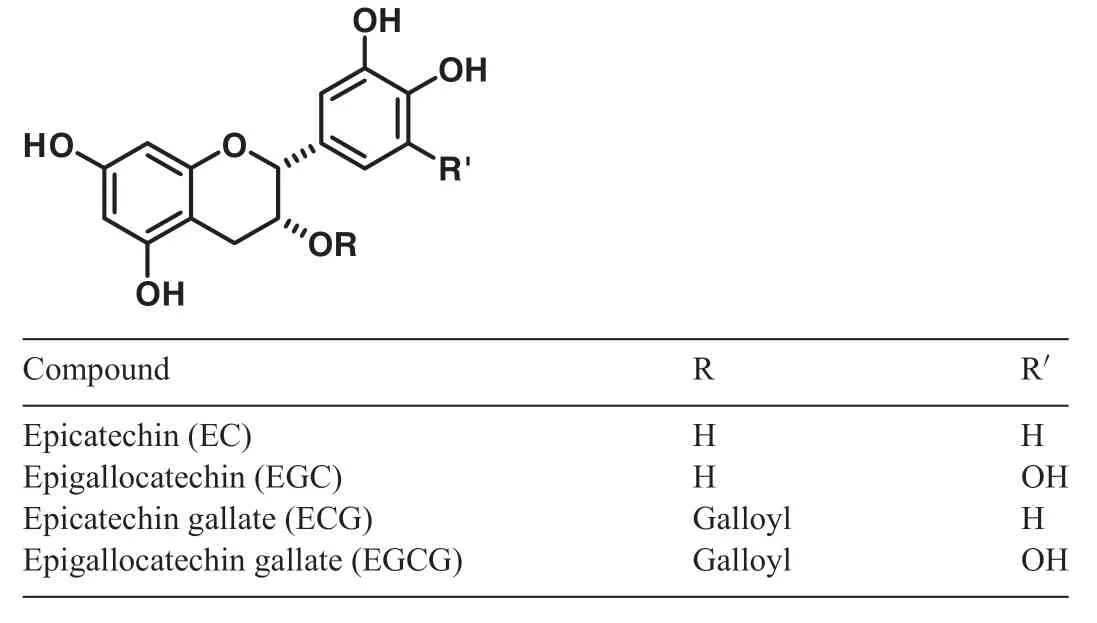
Table 2 Chemical structure of catechins.
2.Cancer prevention and anti-tumor effects of black tea
Cancer is the most common cause of human mortality worldwide.Cancer cells are capable of limitless replication potential due to their self-sufficien growth signals and their resistant to anti-growth signals from host defense that enable them to evade apoptosis.Furthermore,they can sustain angiogenesis that can lead to tissue invasion and metastasis [2].Targeting the regulation of key molecules and cellular signaling pathways in tumorigenesis by natural products was effective in preventing or reducing risk of cancer[3].There are many reports on the effi cacy of the anti-tumor and cancer prevention activity of black tea.For instance,studies from Baker et al.[4]and Doral et al.[5]support the cancer chemo-preventive effect of black tea in the development of prostate cancer,ovarian cancer and rectal cancer.However,others[6,7]do not.The discrepancy of the effects could be a result of actual dosage differences among studies with unspecifie amount ingestion of bioactive tea polyphenols.Daily consumption of black tea in women lowered the concentration of 17β-estradiol(E2),which may reduce hormone-related cancer risk[8](Table 3).Regular black tea consumption is also associated with the reduced risk of ovarian and bladder cancer in female subjects[9-11].Furthermore,several research groups have attempted to elucidate the molecular mechanisms of black tea and its polyphenols.
Drinking black tea reduced incidence and number of skin papilloma in 7,12-dimethylbenz[a]anthracene(DMBA)-treated mice through activation of detoxificatio enzymes and decreased lipid peroxidation [12].Oral administration of black tea polyphenols delayed tumorigenesis,reduced tumor number and volume in DMBA-induced mouse skin carcinogenesis through induction of apoptosis in tumor cells[13].Topical application of combined black tea polyphenols and resveratrol synergistically inhibited DMBA/TPA-induced skin carcinogenesis by reducing tumor incidence,number and volume.Mechanistic study showed that this combination down-regulated mitogen-activated protein kinases(MAPKs)and increased tumor suppressor genep53and apoptosis[14].Consistent with the results in skin cancer model,oral intake of black tea polyphenols or extract also suppressed DMBA-induced mammary tumors and oral tumors by scavenging reactive oxygen species(ROS)that reduced the oxidative stress [15]and down-regulating cyclyoxygenase-2(COX-2),nuclear factor kappa-B (NF-κB) and protein kinase B (Akt) [15],and interfering with the activity of carcinogen metabolizing enzymes[16].
In DMH (1,2-dimethylhydrazine)-induced colorectal tumor model,consumption of tea with high content polymeric black tea polyphenols inhibited the tumorigenesisviadown-regulation of Wnt/β-catenin pathway and proliferative gene expression[17].Oral administration of black tea polyphenols was also effective against arsenic-induced formation of 8-hydroxy-2′-deoxyguanosine (8-OHdG) through up-regulation of DNA repair enzymes in Swiss albino mice[18].
One common feature in the effects of black tea in antagonizing various chemical-induced carcinogenesis is the activation of the detoxificatio enzymes.The detoxifying enzyme system plays an important role in determining the fina fate of carcinogens/procarcinogens and their subsequent impact on carcinogenesis [19].Regulation of many detoxifying enzymes is mediated by the transcription factor nuclear factor E2-related factor 2 (Nrf2) that binds to the antioxidant response element(ARE)/electrophile response element(EpRE),which is located in the promoter region of related genes to initiate gene expression.Ingredients in black tea including EGCG activate Nrf2 and up-regulate the protective enzymes[19,20].In addition to Nrf2 activation,there are many other important mechanisms that contribute to the anti-carcinogenic effects by black tea polyphenols.
Theaflvins (TFs) are major bioactive components in black tea and are classifie as theaflvin(TF1),theaflvin-3-O-gallate(TF2a),theaflvin-3′-O-gallate(TF2b)and theaflvin-3,3′-O,Odigallate (TF3) (Table 1).TFs’ treatment of human leukemic U937 and K562 cells suppressed Akt signaling,thus blocked Wnt/β-catenin signaling,cyclin D1 level and increased levels of FOXO1 and p27 that contribute to induce G0/G1 cell-cycle arrest[21].In HeLa cervical cancer cells,TFs caused apoptosis by generation of ROS,increase of p53 and down-regulation of COX-2 and cyclin D1viablockage of Akt and NF-κB activation[22].
While some of the actions may come from the combinations of TFs,an individual TF has its individual activities against cancer cells.TF1 induced ROS-mediated apoptosis in human malignant melanoma A375 cells through c-Jun Nterminal kinases(JNK)-p38 mitogen-activated protein kinase(MAPK) cascade [23].In a human melanoma cell line,TF1 suppressed enzyme activity and gene and protein expression of metalloproteinases(MMP)-2 by down-regulating epidermal growth factor receptor (EGFR),extracellular regulated protein kinase (ERK) and NF-κB signaling pathways [24].Mutation or inactivation of tumor suppressor gene p53 is frequently found in breast cancer cells and contributes to drug resistant.TF1 induced apoptosis through activating the Fas death receptor/caspase-8 pathway and inhibiting the pAkt/pBad survival pathway in p53-mutated human breast cancer cells [25].Moreover,TF1 inhibited both gene and protein expression of fatty acid synthase(FAS)that could reduce cell lipogenesis and proliferation in MCF-7 breast cancer cells [26].Drinking TF1 in water daily suppressed benzo(a)pyrene (BP)-induced lung carcinogenesis through induction of apoptosis and inhibition of cyclooxygenase-2 (COX-2) expression [27,28]and reduced 4-(methyl nitrosamino)-1-(3-pyridyl)-1-butanone(NNK)-induced cell proliferation and tumor formation in mice [29].TF1was effective in inhibiting 20S proteasome and in reducing proliferation in human multiple myeloma (Arp and Opm1) cells[30].
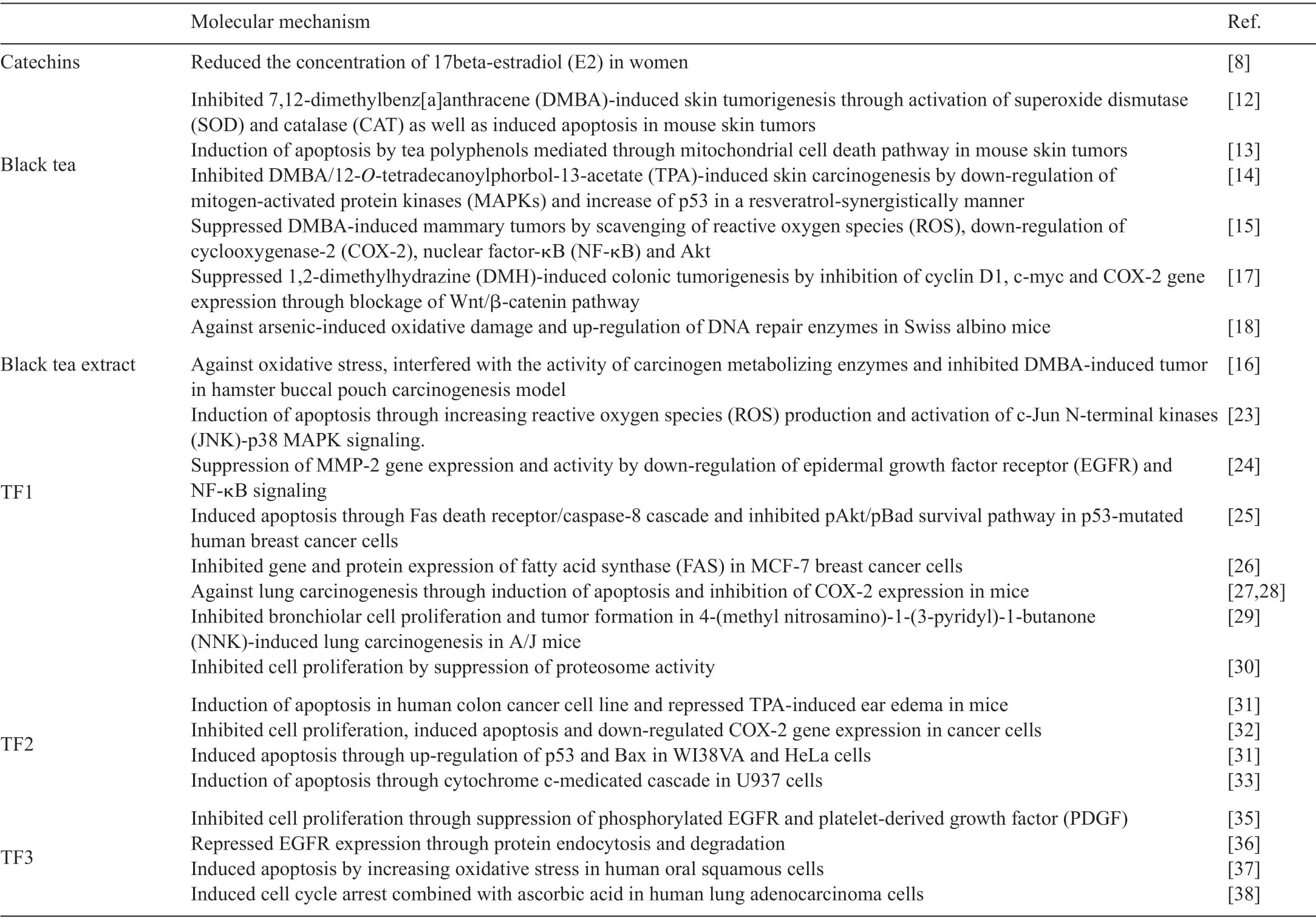
Table 3 Anti-tumor and cancer chemopreventive effect of black tea and its bioactive compounds.
TF2,which includes TF2a and TF2b,triggered mitochondriamediated apoptosis signaling in human colon cancer cells.It also suppressed TPA (12-O-tetradecanoylphorbol-13-acetate)induced COX-2 gene expressionin vitroand ear edemain vivo[31].Treatment with TF2 in SV40 transformed WI38 human cells (WI38VA) caused cell growth inhibition,induction of apoptosis as well as down-regulation of COX-2 gene expression [32].TF2 up-regulated p53 and Bax gene expression that resulted in apoptosis in WI38VA and HeLa cells[31].TF2 also exhibited strong growth inhibitory effect in human histolytic lymphoma U937 cells[33].
Among theaflvins,theaflvin digallate(TF3)also has potent anti-cancer and chemo-preventive properties.TF3 is an potent inhibitor of DNA methyltransferases(DNMT3a),an enzyme in which its upregulation is involved in silencing tumor suppressor genes[34].TF3 showed stronger activity in inhibiting cell proliferation than EGCG in A431 cells and mouse NIH3T3 fibroblas cells by reducing the auto-phosphorylation of EGF and plateletderived growth factor (PDGF) receptors [35].It also reduced EGF-induced EGFR expression by induction of protein endocytosis and degradation[36]and acted as an inducer of oxidative stress that caused apoptosis in human oral squamous HSC-2 cells [37].In combination with ascorbic acid,TF3 showed a synergistic effect in inducing G0/G1 cell cycle arrest in human lung adenocarcinoma cells[38].Overall,various polyphenolic compounds in black tea exert multiple actions against cancer.

Table 4 Protective effect of black tea and its bioactive compounds on cardiovascular disease(CAD).
3.Effects of black tea on cardiovascular diseases
Cardiovascular disease(CAD)is becoming the leading cause of death in the world.Atherosclerosis is considered the major etiology in CAD.In vascular endothelium,low density lipoproteins are oxidized by free radicals forming ox-LDL,which activate and alter the adhesive property of monocytes,leading to their attachment to endothelium[39].The attached monocytes are further differentiated into macrophages,which express scavenger receptors and can uptake ox-LDL.They finall become foam cells and result in the formation of fatty streaks and atheroma plaques[39].The infiltratio of monocytes/macrophages within vascular endothelium causes damage to endothelial cells that in turn results in endothelial dysfunction and reduction in vasodilation capacity in CAD[40].
Epidemiological studies have documented many benefit for cardiovascular health from drinking black tea.Black tea consumption lowered plasma uric acid and C-reactive protein(CRP)levels in both man and women[41](Table 4)and it also reduced serum glucose,triglyceride,LDL/HDL plasma cholesterol ratio and increased plasma antioxidant that may contribute to reduce risk of CAD [42].A clinical study reviewed that short-term(2 h)or long-term(4 weeks)of black tea consumption reversed endothelial dysfunction and improved f ow-mediated dilation of brachial artery in patients with coronary arterial disease[43].Black tea extract is also found to inhibit platelet aggregation in rabbit platelet polymorphonuclear leukocyte (PMN) system[44]that may prevent heart attack or stroke.
Theaflvins,TF1,TF2a,TF2b and TF3,all showed dosedependent antioxidant activity in Cu2+-mediated LDL oxidationin vitro[45].TF1 protected against ischemia/reperfusion injury by inhibiting mitochondrial permeability transition pore(mPTP)opening in isolated heart [46].Dietary administration of TF1 significantl attenuated atherosclerotic lesion size and reduced vascular superoxide,leukotriene B4 (LTB4),and plasma P-selectin concentrations in apolipoprotein E(ApoE)-/-geneknockout mice [47].TF3 also inhibited plasminogen activator inhibitor type 1(PAI-1)activity that contributes to pathogenesis of vascular remodeling and is implicated in the development of myocardial infarction[47,48].
Oxidative stress is involved in endothelial dysfunction that has been considered a risk factor of cardiovascular disease[40].Pre-and post-treatment of black tea extract both showed a protective effect againsttert-butyl hydroperoxide(t-BHP)induced malondialdehyde (MDA) and dityrosine level in human vein endothelial cells (HUVEC) that exhibited beneficia effect on endothelial function [48].Consumption of black tea increased antioxidant capacity in blood in patients with coronary arterial disease [43].In bovine aortic endothelial cells,black tea polyphenols including theaflvins(TF3)and catechins(EGCG)significantl increased endothelial NO synthase(eNOS)activity in bovine aortic endothelial cells and vaso-relaxation activity in rat aortic rings [49].These finding are consistent with the clinical study that black tea consumption reversed the endothelial dysfunction in humans [43]and further demonstrated the effectiveness of tea consumption in combating CVD.
4.Effects of black tea in chronic inflammatory diseases
Chronic inflammatio is a key component in many human chronic diseases and conditions,including rheumatoid arthritis,inflammator bowel disease (IBD),osteoporosis and allergy [50-53].Activation and infiltratio ofinflammator cells as well as excessive production of pro-inflammator cytokines/chemokines are major characteristics and etiology in chronic inflammator diseases.Inhibition ofinflammator cells recruitment and pro-inflammator mediator production are considered the important steps targeted by natural dietary compounds in prevention or treatment of chronic inflammator diseases[54].
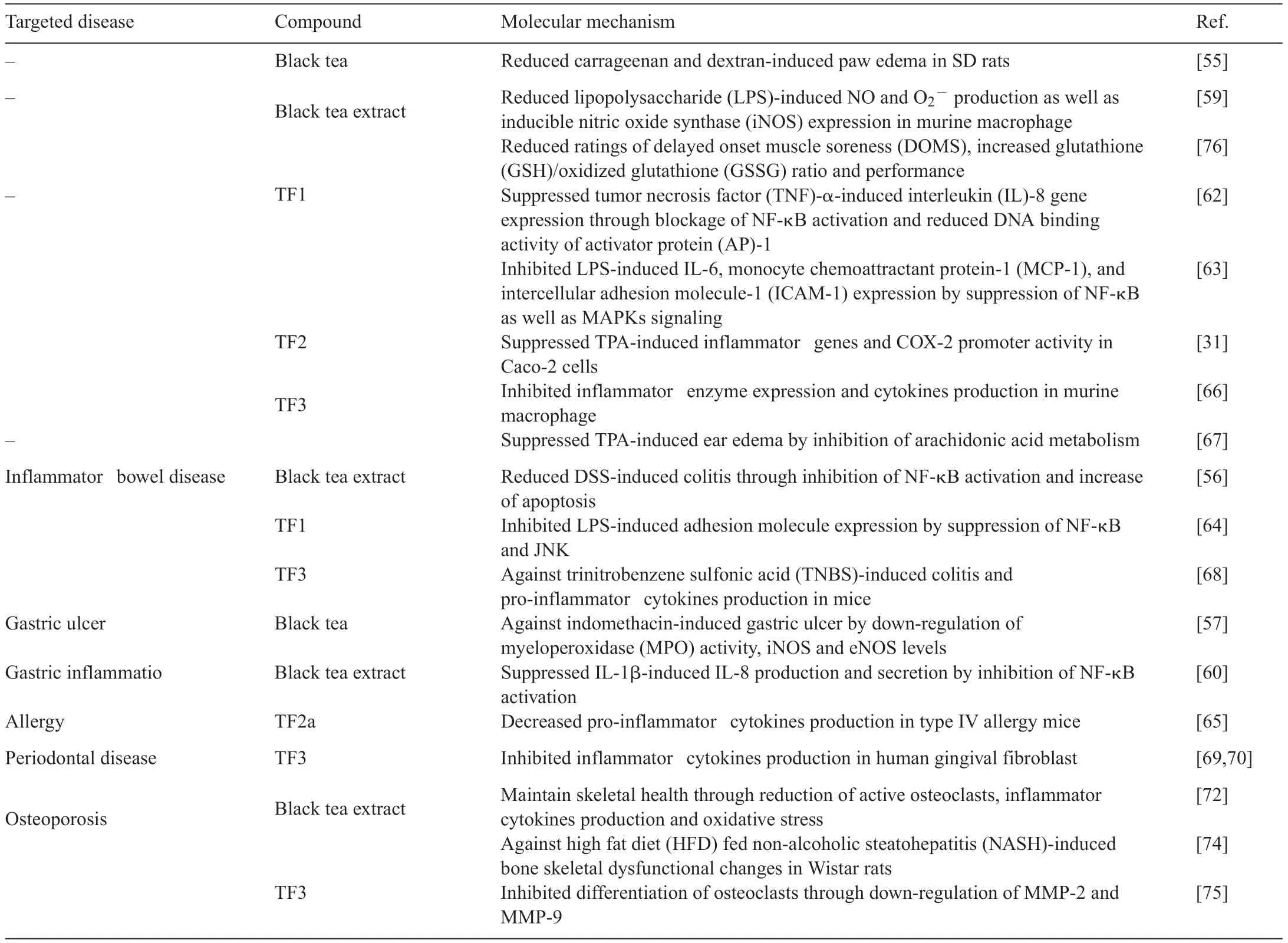
Table 5 Effect of black tea and its bioactive compounds on chronic inflammator diseases.
There are many well-documented anti-inflammator effects of feeding black tea or its extract in animal models.Black tea effectively reduced carrageenan/dextran-induced paw edema[55]and dextran sulfate sodium (DSS)-induced colitis [56]and improved healing against indomethacin-induced stomach ulceration [57](Table 5).One key feature of these antiinflammator effects of black tea isviathe inhibition of NF-κB[56].NF-κB is a transcription factor that plays a central role in inflammatio through its ability to induce transcription of pro-inflammator genes.NF-κB is highly activated at sites ofinflammatio in diverse diseases and can induce transcription of pro-inflammator cytokines,chemokines,adhesion molecules,MMPs,COX-2,and inducible nitric oxide(iNOS)[58].Inhibition of NF-κB can effectively reduce the production of various pro-inflammator mediators and enzymes including COX-2 and iNOS and switch offinflammatio and therefore is considered a key target for anti-inflammator therapeutics [58].The antiinflammator effects of black tea are further confirme by cell model that using black tea extract reduced nitric oxide (NO)and O2-production [59]and inhibited the effects of proinflammator cytokines[60].
Consistent with the results using black tea or its extract,major ingredients in black tea including TFs and EGCG inhibited the induction of NF-κB [61]and thus were able to reduce inflam mation mediators.By blocking NF-κB,TF1 inhibited tumor necrosis factor(TNF)-α-mediated interleukin(IL)-8 gene[62]and the expression of LPS-induced interleukin-6(IL-6),monocyte chemoattractant protein-1(MCP-1),intercellular adhesion molecule-1 (ICAM-1) and vascular cell adhesion molecule(VCAM)-1viathe modulation of MAPKs signaling[63,64].
By modulation multiple transcription factors including NFκB,AP-1 and CREB,TF2 treatment suppressed TPA-induced inflammator gene expression in Caco-2 cells,such as COX-2,TNF-α,ICAM-1,and iNOS.It also reduced COX-2 promoter activity [31].Oral administration of TF2a reduced levels of pro-inflammator cytokines,including IL-12,IFN-γ,and tumor TNF-α in type IV allergy in male ICR mice[65].
Variousin vitroandin vivomodels demonstrated the anti-inflammator effects of TF3.Similar to TF1 and TF2,suppression of NF-κB by TF3 inhibited LPS-induced iNOS expression in RAW264.7 macrophage [66].In TPA-induced mouse ear edema model,TF3 showed stronger inhibitory effectthan other tea polyphenols in reducing of IL-6,prostaglandin E2 (PGE2),and LTB4 levels [67].Oral administration of TF3 decreased both gene and protein levels of TNF-α,IL-12,interferon (IFN)-γ and iNOS in trinitrobenzene sulfonic acid(TNBS)-induced colitis animal model [68].TF3 suppressed IL-16 and CXC chemokine ligand 10 (CXCL10) production by targeting multiple signaling pathways in human gingival fibroblast [69,70],which play a critical role in sustaining inflammator response in the pathogenesis of periodontal disease[71].

Table 6 Effect of black tea and its bioactive compounds on obesity and metabolic syndrome.
Mononuclear cell infiltratio and osteoclast activation have been linked to bone loss [52].Black tea extract feeding effectively preserved and restored skeletal health by reducing osteoclast activation and oxidative stress caused by mononuclear cells in rats [72].Osteoporosis is a common complication associated with chronic liver disease [73].In high fat diet(HFD)-induced non-alcoholic steatohepatitis (NASH) model,consumption of black tea extract ameliorated bone skeletal dysfunctional changes,including bone turnover and density[74].In addition,it was found that TF3 and EGCG inhibited the formation and differentiation of osteoclasts through decreasing gene expression of MMP-2 and MMP-9 as well as their enzymatic activities.These results supported the role of black tea polyphenols in preventing the degeneration of the matrix in bone and cartilage[75].
Delayed onset muscle soreness (DOMS) frequently occurs in athlete after high intensity exercise.Muscle soreness,which is initiated by muscle damage,is usually noted at 24 h post-exercise and can last as long as 5-7 d post-exercise.The muscle damage elicits inflammator and oxidative responses that may exacerbate muscle injury and prolong the time to regeneration [76].In a human trial study of healthy athletes engaging in high intensity anaerobic exercise,supplement with TF2-enriched black tea extract significantl reduced DOMS,increased glutathione(GSH)/oxidized glutathione(GSSG)ratio and performance [76].These results are consistent with the molecular actions of black tea polyphenols that they activate transcription factor Nrf2,which up-regulates protective detoxifying and antioxidant enzymes including enzyme for glutathione biosynthesis and metabolism to maintain glutathione levels[19].Activation of Nrf2 also attenuates the NF-κB mediated inflam matory response [77],which may play a significan role in anti-inflammator effects of black tea.
5.Effects of black tea in obesity and metabolic syndrome
Obesity is a highly prevalent condition and regarded as a risk factor for cardiovascular disease,hypertension and metabolic syndrome,fatty liver disease,type 2 diabetes and chronic kidney disease [78].Obesity is currently considered a chronic inflammator disorder that promotes the development ofinsulin resistance and diabetes [77].In a high fat diet (HFD) induced obesity animal model,drinking black tea or its extract decreased body fat [79],and improved hyperglycemia and glucose intolerance [79](Table 6).Consumption of black tea up-regulated glucose transporters type 4 (GLUT4) in muscle that resulted in increased glucose uptake and improved glucose intolerance[79].It also suppressed C/EBPβ expression in perirenal fat that implicated in adipocyte differentiation and fat accumulation [80].Dietary feeding black tea polyphenol extract also suppressed HFD-or high sucrose-induced increased liver lipid content or dyslipidemia in animals [81].The potential mechanisms include decreased hepatic fatty acid synthase(FAS)and increased AMP-activated protein kinase(AMPK)activity[82].AMPK is the key cellular energy sensor that regulates glucose and lipid metabolisms and is the drug target of anti-diabetic drug such as metformin[83,84]and lipid-lowering drug,statins[84].Activation of AMPK leads to increased glucose uptakeviaupregulation of glucose transporters,turning off anabolic pathways including decreased fatty acid synthase for lipid synthesis and increased catabolic pathways in cells[83].In agreement with thein vivoresults,in vitrostudy showed that theaflvins and EGCG treatment strongly reduced intracellular total lipid,triglyceride,and cholesterol levels in fatty acid (FA)-overloaded liver cell line through activating AMPK signaling pathway[85],and TF1 was found to inhibit both gene and protein expression of FASin vitrothat may reduce cell lipogenesis[26].
Other possible mechanism of black tea against obesity and dyslipidemia also has been proposed.Both TF2a and TF2b are found to reduce micellar solubility of cholesterolin vitro[86,87].Moreover,TF3 is more effective in inhibiting pancreatic lipase activity than that of EGCG by reducing triacylglycerol absorption and consequently suppressing postprandial hypertriacylglycerolemia[88].These actions contributed to the prevention of black tea polyphenols against diet-induced obesity in animals[81].
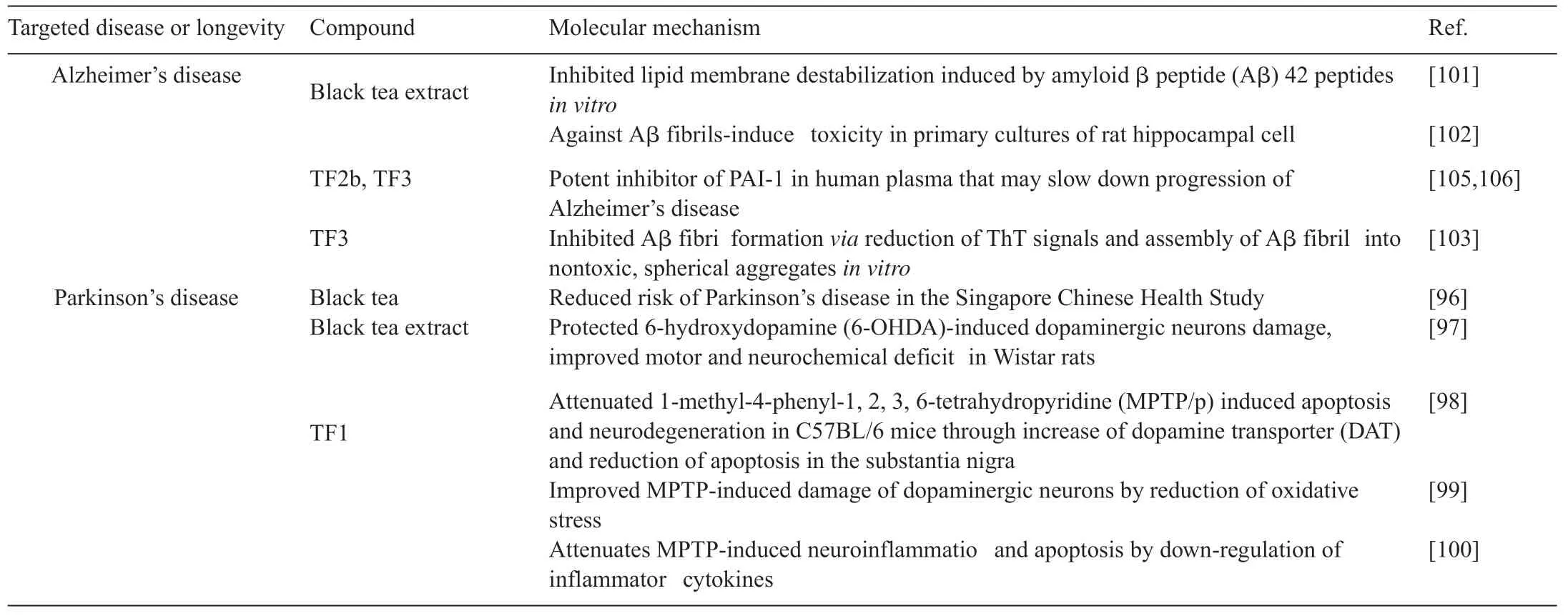
Table 7 Effect of black tea and its bioactive compounds on neurological disorders.
In addition to the effects of reducing postprandial lipids absorption,drinking black tea also reduced postprandial blood glucose levels and enhanced insulin response in healthy human subjects [89].Solutions of black tea increased insulin activity in rat adipocytes [90].One of the potential mechanisms includes theaflvins mimicked the effects ofinsulin and insulinlike growth factor-1 (IGF-1) by initiating phosphorylation of Forkhead transcription factor O1a (FOXO1a) and repressing phosphoenolpyruvate carboxykinase(PEPCK)promoter activity.FOXO1a and PEPCK are both important components of the insulin-signaling pathway [91].The phosphorylation of FOXO1a may be mediated by AMPK[92,93],which is the key metabolic regulatory enzyme activated by black tea polyphenols.
6.Potential use of black tea in neurodegenerative disorders
Parkinson’s disease(PD)and Alzheimer’s disease(AD)are age-dependent neurodegenerative disorders [94].Parkinson’s disease is characterized by accumulation of α-synuclein protein of Lewy bodies and loss of dopaminergic neurons [95].Consumption of black tea was associated with the reduced risk of Parkinson’s disease in an epidemiology study.It was concluded that ingredients of black tea other than caffeine were responsible for the beverage’s inverse association with Parkinson’s disease [96].In 6-hydroxydopamine (6-OHDA)-lesioned rat model of PD,oral administration of black tea extract before or after 6-OHDA treatment reduced dopaminergic neuron damage and improved motor and neurochemical deficit [97].In another neurotoxin 1-methyl-4-phenyl-1,2,3,6-tetrahydropyridine (MPTP)-induced PD animal model,oral treatment of TF1 was effective in reduction of oxidative stress-induced neurodegeneration and apoptosis by suppressing Bax down-regulation and increasing Bcl-2.It also effectively reduced inflammator mediators (IL-1β,IL-6,TNF-α,IL-10)and ameliorated dopamine transporters’ reduction and behavioral deficit [98-100].
Black tea may also be beneficia in the treatment of AD.In AD,it is believed that the neurodegeneration is caused by the cleavage product of amyloid precursor protein (APP) and the aggregation of amyloid β peptide (Aβ) in brain.Black tea extract inhibited Aβ42 peptides-induced lipid membrane destabilization that may protect membrane damage[101](Table 7).In primary culture of rat hippocampal cell,black tea extract displayed neuroprotective effect by the inhibition of Aβ-induced cytotoxicity[102].Black tea polyphenols including theaflvins and EGCG inhibited formation of toxic amyloid-β (Aβ) and α-synuclein(αS)fibrilin vitroby stimulating the assembly of Aβ and αS into nontoxic spherical aggregates that are independent of their antioxidant effects[103].TF3 was less susceptible to oxidation and had an increased effica y under oxidizing conditions than EGCG[103].EGCG was effective in reducing the β-amyloid mediated cognitive impairment in Alzheimer transgenic mice [104].It would be interesting to fin out if TF3 is more potent in same animal model.In addition to the direct effects on Aβ aggregation,both TF2a and TF3 were found to inhibit PAI-1 activity,which has been implicated in the accumulation of Aβ plague in brain [105,106].Results from all thesein vitrostudies look promising and furtherin vivoand clinical studies are needed to confir the effica y of black tea polyphenols in the treatment of PD and AD.
7.Summary and perspective
In summary,black tea and its extracts possess many health promoting properties supported by a myriad of data fromin vitroandin vivoexperiments as well as human clinical trials.The major black tea polyphenols,theaflvins and catechins should be recognized as biomolecular markers of black tea and its extract.Delineating biological mechanisms that are associated with a well-characterized chemical profil will provide crucial information for product development in targeting specifi conditions.
The key molecular action of black tea polyphenols include the activation of Nrf2 transcription factor that up-regulates detoxifying and antioxidant enzymes.This action may also contribute to the inhibition of NF-κB,the master transcription factor that regulates inflammation Black tea polyphenols also activate AMPK the key cellular energy sensor that regulates glucose and lipid metabolisms.All these diverse actions provide the scientifi foundation in supporting the consumption of black tea or its extract for the prevention of cancer and treatment of many inflammator and metabolic diseases.
- 食品科學與人類健康(英文)的其它文章
- Changes in physicochemical properties of proteins in Kayserian Pastirma made from the M.semimembranosus muscle of cows during traditional processing
- Polyphenolic extract of Sorghum bicolor grains enhances reactive oxygen species detoxificatio in N-nitrosodiethylamine-treated rats
- Protective role of concomitant administration of fla lignan concentrate and omega-3-fatty acid on myocardial damage in doxorubicin-induced cardiotoxicity
- Epigenetic origins of metabolic disease:The impact of the maternal condition to the offspring epigenome and later health consequences
- GUIDE FOR AUTHORS
- Natural products for cancer prevention associated with Nrf2-ARE pathway

